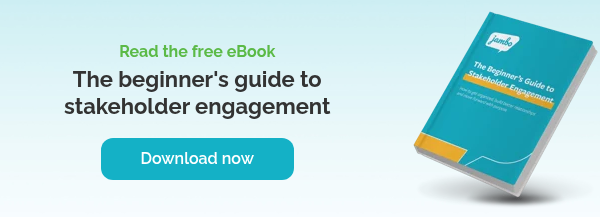
Whether you're focused on stakeholder engagement, risk management, meeting regulatory requirements, or developing positive stakeholder relationships, trust is vital. We've compiled this detailed list to help you learn how to build trust.
Seven ways to build stakeholder trust
1. Research your stakeholders
Building stakeholder trust begins with researching your stakeholders, providing a strong foundation of information to ensure your interactions with them are sincere. This is important because, by attending your engagement sessions having researched them, you can demonstrate to your stakeholders that you've taken the time to learn about them, are invested in them, and are willing to listen.
2. Seek to understand your stakeholder's history with engagement
The more you seek to understand your stakeholders and their unique perspectives, the more you'll be able to engage in more relevant and meaningful ways for everyone. You need to determine if they have a prior history with your organization and, if possible, if they have been involved in a similar engagement process.
You may identify places where trust has been broken in the past, either by your organization, a similar organization, or a similar process. You'll want to understand those pain points affecting your stakeholders and be mindful that those negative past experiences will need to be accounted for and considered.
Remember, it is not just about building a relationship for the duration of this one project. You're building trust for years to come, so you need to seek to understand your stakeholders ' history with your organization, as it can impact your ability to build trusting relationships now and in the future.
3. Ask questions to learn what's important to your stakeholders
You'll inevitably need to ask some questions when researching and working to understand your stakeholders' engagement history. If there's a history, it's worthwhile to ask your internal team(s) about your stakeholders, as this can provide some crucial insights into what your stakeholders might care about and how they may already feel about your organization.
Beyond asking your team(s), ask your stakeholders for information about what's important to them. By asking your stakeholders for their perspectives instead of making assumptions, you'll demonstrate that you care about what's important to them, which will go a long way toward building trust.
4. Be honest about what your stakeholders can expect from you
From the start, be honest and open with your stakeholders about what they can expect from you and this entire process (and let them know if anything changes). Stakeholders don't want to enter a process and expect to have a say in whether a project moves forward, only to discover that the project has already been decided upon, and they have no say.
In the Spectrum of Public Participation developed by the International Association for Public Participation (IAP2), there are five levels of participation (i.e., inform, consult, involve, collaborate, and empower). To help build trust, you'll want to clarify where your engagement with stakeholders lies on that spectrum from the start. Don't tell somebody that they're going to be able to directly inform the "yes or no" decisions of a project if they're actually at the "inform-level" and not the "empower-level."
Remember, your stakeholders have taken the time to join the conversation and the process, so be respectful of their time by being honest about what they can expect and what you'll do with the information and feedback they share with you.
5. Follow through on all your stakeholder commitments and promises
A crucial way to build trust is by consistently following through on every commitment or promise made to your stakeholders. For example, if you've agreed to email a stakeholder once a month or send them a document after a meeting, then follow through accordingly. In trusting relationships, it's not enough to say you'll do something; your words and actions must be consistent with each other.
Pro-tip for following through on stakeholder commitments: Following through doesn't just help build trust; it's also a crucial tool for managing stakeholder engagement risks. To ensure you never miss a commitment, it is essential to be aware of every promise made to your stakeholders and have the means to track their progress. Stakeholder Relationship Management (SRM) software can help you effectively manage your stakeholder commitments.
6. Acknowledge and communicate with your stakeholders when you make a mistake
How you communicate with your stakeholders during and after a mistake can impact your project's risk level and the degree of trust your stakeholders have in your organization moving forward. So, what do you do when you make a mistake?
If you happen to forget a commitment or if something goes wrong, be honest with your stakeholders, acknowledge the mistake, and apologize if necessary. By owning up to any errors, you demonstrate your commitment to your stakeholder relationships and your dedication to rectifying the situation.
Once your stakeholders see your willingness to improve and rectify your mistakes, they'll likely perceive your commitment to honesty and transparency, which are key pillars of trusting relationships. This honesty and transparency (that we don't always see from all organizations) can strengthen trust over time and help mitigate any risks that arose from the mistake.
It's essential to acknowledge your mistakes and not play them off as "nothing" or blame them on someone else. Stakeholders will know if you're trying to hide something from them, so it's much better to be honest and explain what has happened immediately.
When communicating with a stakeholder about a mistake, lead with the facts and give them time, space, and opportunities to express their feelings about the situation. While this isn't always easy, keep communication channels open and navigate this process with support from leadership in your organization, so that everyone works together in an aligned, factual, and honest manner.
Learn how to manage and improve stakeholder relationships with proven frameworks and tools →
7. Be proactive within your stakeholder relationships
When we describe someone as being proactive, they're often someone we can count on to "get things done." Being proactive in stakeholder engagement means your stakeholders can count on you to take responsibility for what's happening in your project(s) and to seek out the best possible solutions in a productive and honest manner.
People will support what they help create and build, so your stakeholders mustn't feel burned by your choices and actions. They'll need continuous honesty and transparency about what they can expect from you, the process, and the project to build trust. They'll need a clear understanding of where their opportunities for influence lie and an assurance that you'll communicate as things occur, that you'll stand by your word, and that you'll make things right if any missteps arise along the way.
Everything we've shared here today requires a commitment on your part, but the trust you'll earn in return is well worth the time and effort you'll invest.
Key takeaways
|
Next steps: Download the beginner's guide to stakeholder engagement
For those new to stakeholder engagement and seeking more information, we recommend checking out our Beginner's Guide to Stakeholder Engagement. This 27-page eBook helps you learn how to get organized, build better relationships, and move forward purposefully.







